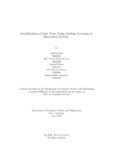| dc.contributor.advisor | Akhond, Mostafijur Rahman | |
| dc.contributor.author | Saif, Mehruz | |
| dc.contributor.author | Kanon, MD. Kamal Haque | |
| dc.contributor.author | Hasan, Nazmul | |
| dc.contributor.author | Hossen, MD. Shamim | |
| dc.contributor.author | Anannya, Fatema Zohra | |
| dc.date.accessioned | 2021-10-10T09:28:29Z | |
| dc.date.available | 2021-10-10T09:28:29Z | |
| dc.date.copyright | 2021 | |
| dc.date.issued | 2021-06 | |
| dc.identifier.other | ID 19101665 | |
| dc.identifier.other | ID 19201139 | |
| dc.identifier.other | ID 19301277 | |
| dc.identifier.other | ID 15301101 | |
| dc.identifier.other | ID 17101176 | |
| dc.identifier.uri | http://hdl.handle.net/10361/15199 | |
| dc.description | This thesis is submitted in partial fulfillment of the requirements for the degree of Bachelor of Science in Computer Science and Engineering, 2021. | en_US |
| dc.description | Cataloged from PDF version of thesis. | |
| dc.description | Includes bibliographical references (page 41-42). | |
| dc.description.abstract | The World Wide Web’s launch and the rapid adoption of social media platforms
(such as Facebook and Twitter) paved the way for unparalleled levels of information
diffusion in human history. Consumers are creating and sharing more information
on social media platforms than ever before, some of it is erroneous, deceptive, or has
no influence on reality. Access to news information has become considerably simpler
and more comfortable thanks to the Internet and social media. Online users may
often follow events of interest, and the widespread usage of mobile devices makes
this process easier. However, with great potential comes enormous responsibility.
There are also a number of websites dedicated nearly entirely to the dissemination
of fake news. Since it’s a serious issue with a large-scale dataset, identification of
fake news is very vital in this era, as social media and online newspapers are in
large numbers in the web arena. That’s why it is easy to spread rumors and create
chaos. Also, the size of data sets is increasing day by day. Data is expanding
at a quicker rate than processing rates. As a result, algorithms that need a huge
quantity of data and processing are frequently conducted on a distributed computing
system that separates multiple nodes on several machines which have concurrency of
components and lack of a global clock. Also, nobody has used a distributed system
to detect fake news before. In our paper, we tried to run 4 PySpark algorithms
based on SPARK-Context which provides massive storage for big data processing
and analysis and also has been found to be 100 times quicker in-memory, while disk
performance was shown to be 10 times quicker on several devices at the same time.
So that we can control and real-time monitoring over the news and data before it
goes viral in the media. | en_US |
| dc.description.statementofresponsibility | Mehruz Saif | |
| dc.description.statementofresponsibility | MD. Kamal Haque Kanon | |
| dc.description.statementofresponsibility | Nazmul Hasan | |
| dc.description.statementofresponsibility | MD. Shamim Hossen | |
| dc.description.statementofresponsibility | Fatema Zohra Anannya | |
| dc.format.extent | 42 pages | |
| dc.language.iso | en | en_US |
| dc.publisher | Brac University | en_US |
| dc.rights | Brac University theses are protected by copyright. They may be viewed from this source for any purpose, but reproduction or distribution in any format is prohibited without written permission. | |
| dc.subject | PySpark ML | en_US |
| dc.subject | RDD(Resilient Distributed Dataset) | en_US |
| dc.subject | Random Forest | en_US |
| dc.subject | Factorization Machine Classifier | en_US |
| dc.subject | Linear SVC | en_US |
| dc.subject | Logistic Regression | en_US |
| dc.subject.lcsh | Machine Learning | |
| dc.title | Identification of fake news using machine learning in distributed system | en_US |
| dc.type | Thesis | en_US |
| dc.contributor.department | Department of Computer Science and Engineering, Brac University | |
| dc.description.degree | B. Computer Science | |

